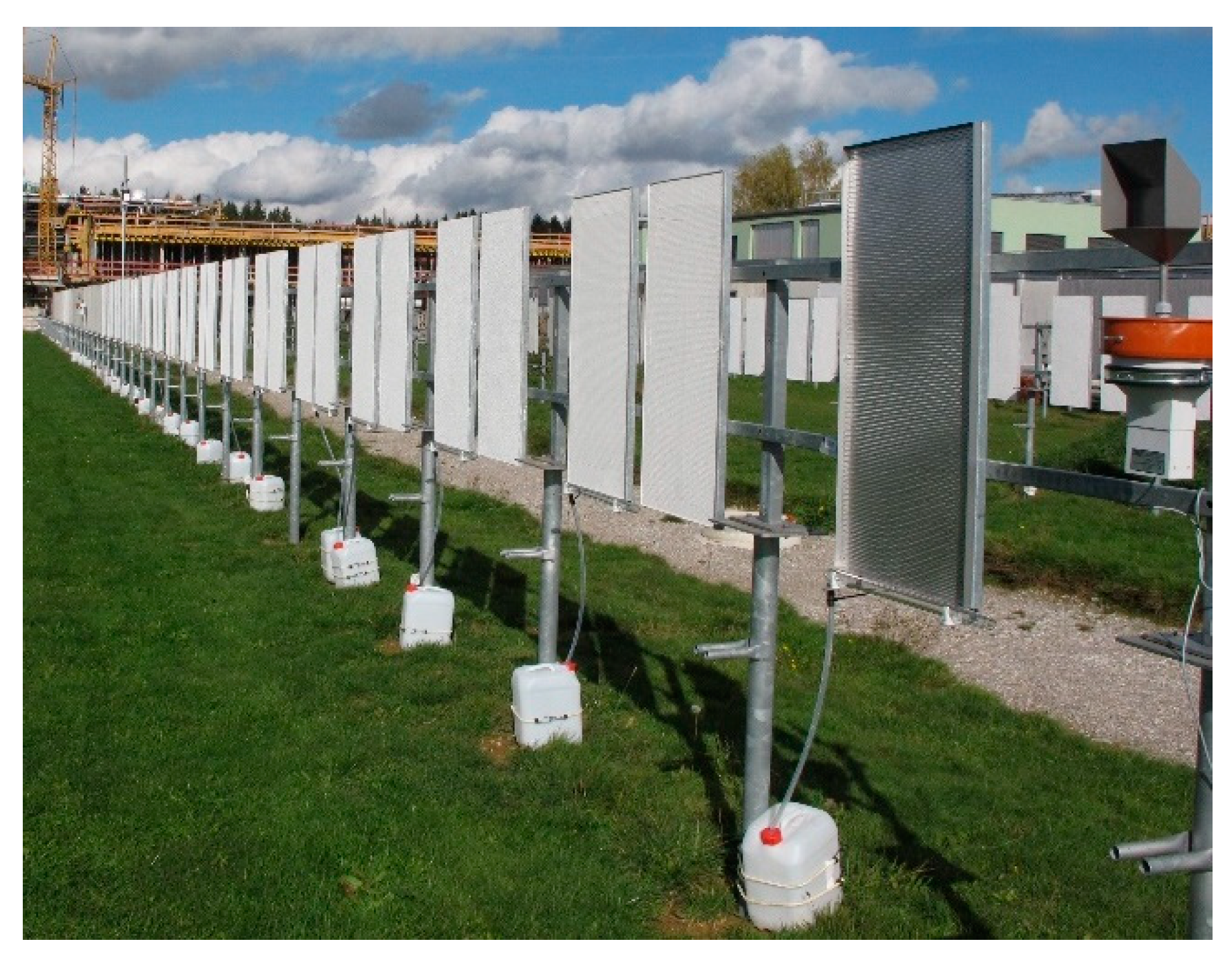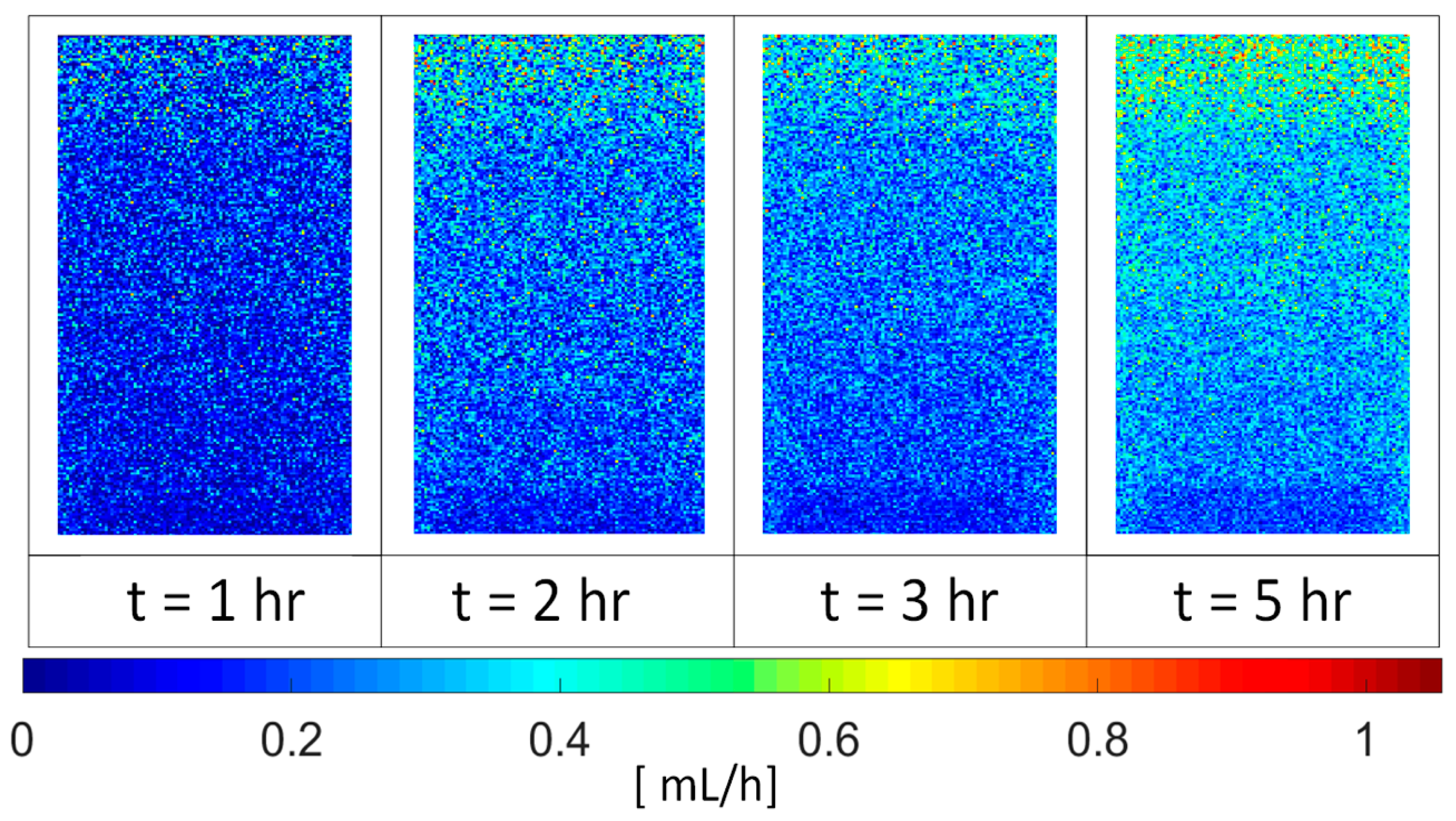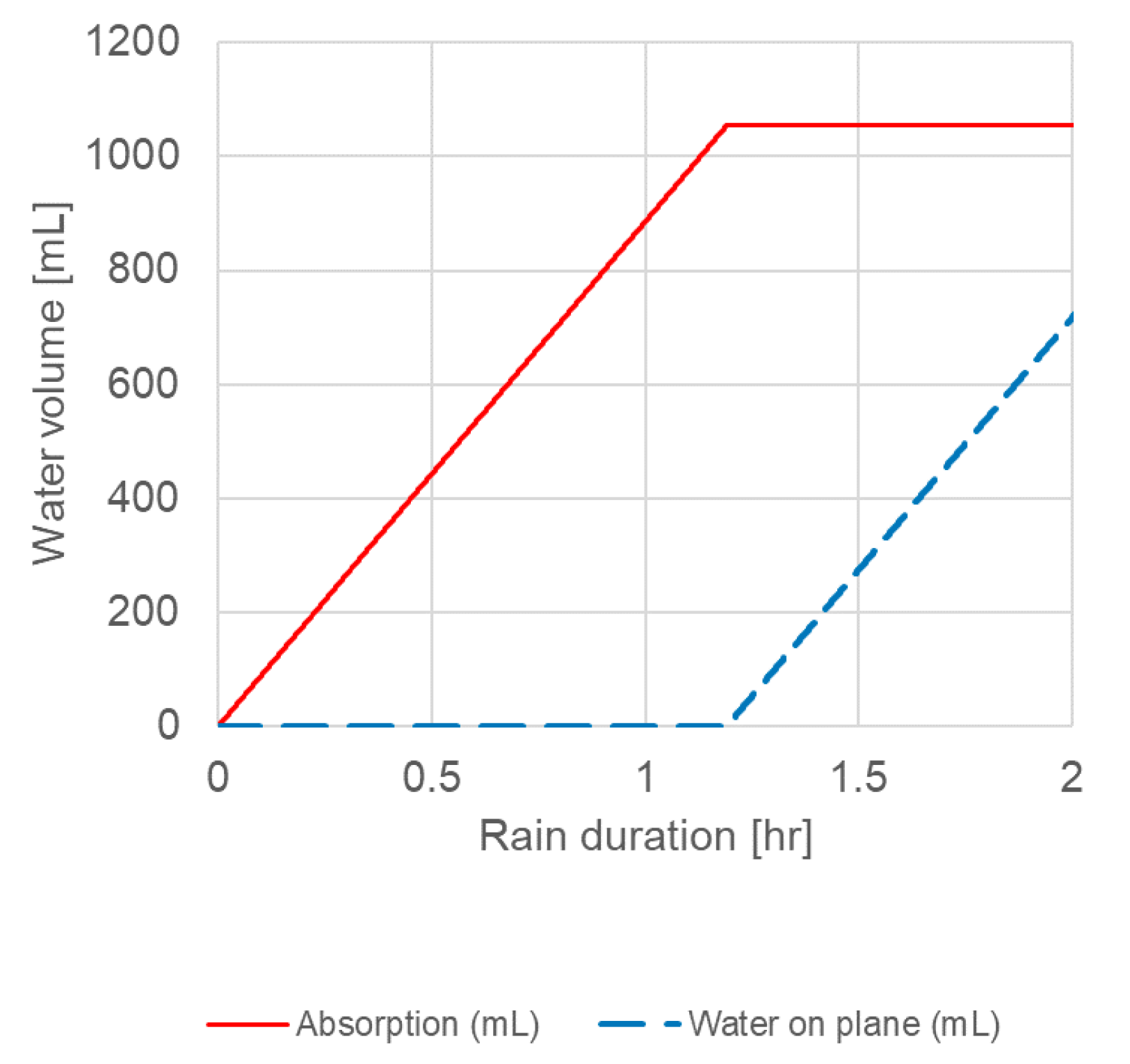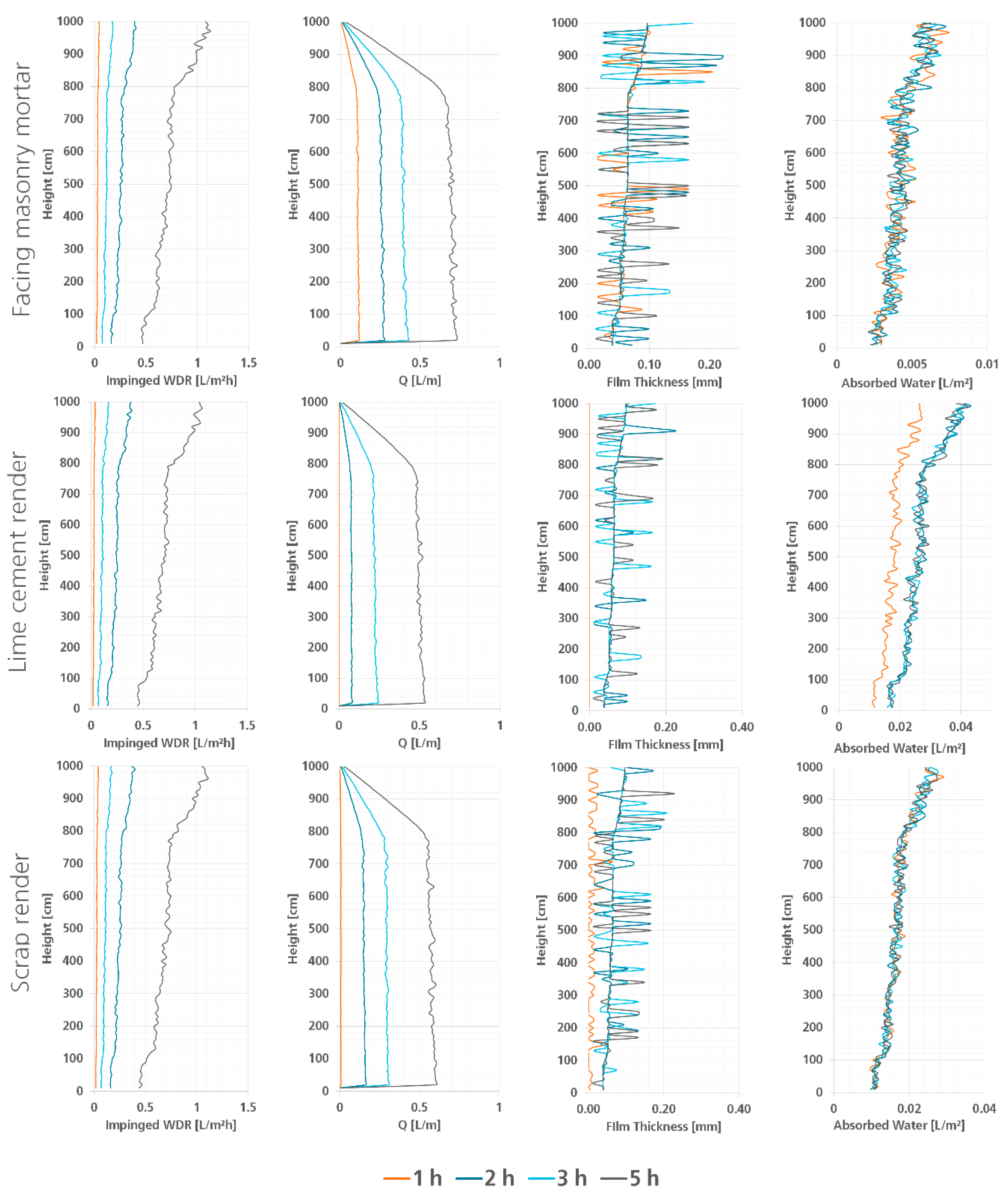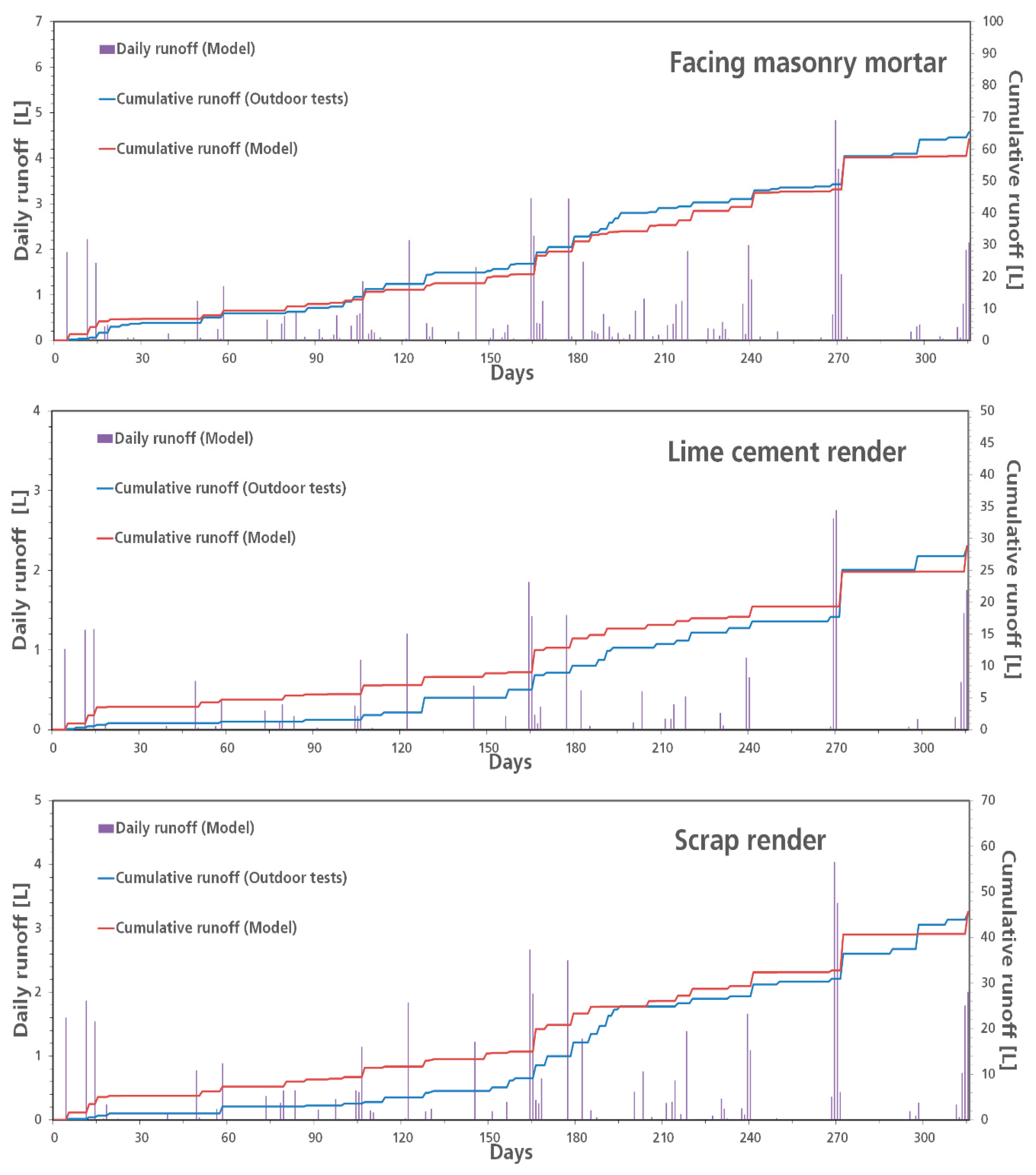1. Introduction
In the European Community, the evaluation of the environmental properties of building materials has been a high priority for some years. The Construction Products Regulation (CPR) addresses seven basic requirements for buildings [
1]. The third requirement covers the area of hygiene, health and environmental protection. According to the latter, construction projects must be designed in such a way that, throughout their entire life cycle, they will not have an exceedingly high environmental impact. Plaster and mortar are mostly used as part of façade external thermal insulation composite systems (ETICS). During the exposure of these products to precipitation and ambient air, the stormwater runoff from the façades dissolves some ingredients from the plaster and mortar. The leached substances can be released into the environment in this way. Since not every substance has an environmentally hazardous potential, the release of substances from construction products in contact with stormwater does not necessarily imply a negative impact on the environment.
Vertical test panels (VTP) (see
Figure 1) have been widely used to investigate the leaching of ingredients of building materials, e.g., façade coatings, ETICS, mortars or plasters [
2,
3,
4,
5,
6,
7,
8]. These panels are commonly used to gain information on the leaching of substances from building products in real weather conditions. However, the evaluation of the leaching behavior of plaster and mortar in the case of a façade in contact with stormwater by using models is not yet possible, as there is no transfer model for reaching conclusions, from the results of leaching tests, on the actual impact of a building product on soil and groundwater.
During rain events, building ETICS façades become moist due to wind-driven rain (WDR), a horizontal velocity component of the wind that is driven against the windward façade of buildings. WDR is the most important contributor to the moisture load on building façades [
2,
4,
9,
10,
11,
12,
13]. Burkhardt [
4] first postulated that weather conditions (precipitation, rain intensity, wind speed, wind direction, temperature), façade geometry (height, weight), site characteristics (latitude, altitude) and façade exposure (orientation) are the main influencing factors of the leaching process.
Many studies in recent decades have focused on the prediction of impinging WDR on building façades. These models have focused on predicting the amount of WDR that affects a façade by using semi-empirical formulas [
14] and numerical simulations with Computational Fluid Dynamics (CFD). A summary of these methods can be found in Blocken et al. [
10]. To approach WDR in a façade, there exist two different methods according to Abuku [
15]: (1) The average moisture flux of a façade is supplied by the total mass of all raindrops impinging on the material surface during a defined time interval established by the meteorological input data and (2) the WDR is the sum of individual raindrops impinging on the façade in a spatially and temporally discrete modus. In the CFD model, the airflow patterns were studied using computational fluid dynamics. By using this method, the catch ratios can be calculated by simulating the raindrop trajectories based on the airflow patterns. The raindrop catch ratios are then used to construct distributions for different zones, as a function of the rain intensity and the wind speed. Heat-Air-Moisture (HAM) models have been assessed to take into account the absorption as well as the moisture response of the façade caused by impinging WDR, including drop bouncing and runoff along the surface [
16,
17,
18,
19,
20]. Liquid film flow models have been largely studied in the past for other disciplines [
21,
22,
23,
24], but very few investigations have been done coupling them with vertical surfaces and the hygrothermal behaviors of façades [
11]. Blocken et al. [
9,
10] numerically studied the coupling between façade liquid film flows in combination with simplified absorption models like that of Hall and Hoff [
25,
26]. Simulations typically overestimate the measured moisture content in facades. This may be caused partly by two errors: (1) errors in the difference in absorption and evaporation between an averaged WDR flux and a flux composed of randomly impinging drops, and (2) errors concerning the behavior of the raindrops, as splashing and bouncing may be processes that decrease the availability of water for absorption and laminar flow [
20].
The surface runoff that occurs following water saturation of the façade material is of special interest because leaching is controlled by the availability of water in the surface as well as the transport processes within the materials [
27]. To model the runoff of the VTP, it is necessary to combine a variety of processes, e.g., WDR impingement in the vertical plane, material absorption, and surface runoff. In this study, the runoff caused by WDR on VTP coated with three different types of plaster and mortar will be simulated. Based on previously developed models, methods and assumptions, the calculation of impinged raindrops in the VTP, as well as the amount of absorbed water and the surface runoff will be assessed. In order to compare the results between the model and the runoff volumes obtained during the field tests, real weather parameters as well as the physical properties of the materials will be used as input parameters.
Over a period of 10 years, the Fraunhofer Institute for Building Physics IBP has carried out systematic and extensive investigations on a large number of formulations of plaster and mortar. A series of field scale tests using vertical test panels comprising various plaster and mortar coatings has been carried out in order to analyze the leaching behavior during real weather conditions as well as in constant physical conditions. The data were used as a basis in the development process of a three-stage model to assess the environmental properties of common plaster and mortar:
Level 1: Façade runoff model
Level 2: Model for leaching processes and material transport on façades
Level 3: Evaluation of the environmental impact by using the leachate forecast for groundwater risk assessment
This study will focus on the “Level 1: Façade runoff model”, in which a runoff numerical simulation model for VTP in MATLAB was developed. The model calculates the water volume that sorbs during the rain event, bounces off the façade, and runs off it or remains on it as a film. The method in this simulation is based on stated assumptions found in previous research papers and existing WDR, absorption, and surface water flow models.
3. Results
The runoff was calculated using the established absorption model and the WDR distribution assessment model of Blocken [
30]. The flow speed and the film thickness were analyzed and compared to the solutions of Beijer and Nusselt. Finally, the results were compared with existing runoff volumes obtained over an 18-month VTP outdoor testing period.
3.1. Wind-Driven Rain Distribution
In the CFD Model by Blocken [
30], the WDR load in the VTP was determined by the multiplication of catch ratios with the rainfall intensity. In
Figure 2, the WDR distribution for 0°, which was used for the previously specified rain event, can be seen. The figure shows that the magnitude of impinged water volume varies according to the exposure time of the VTP to the rain event. The upper edges of the VTP received the highest amount of WDR, while the lower part received the least amount of WDR.
For the VTP that was exposed for t = 5 h, some elements in the upper edges received up to 0.8 mL and 1.2 mL of water in comparison with the VTP exposed to t = 1 h, which only received up to 0.4 mL during the rain event. The cumulative WDR received by the VTP for the surface exposed to t = 1 h was 1.3 L, for t =2 h 2.5 L, for t = 3 h 3.8 L, and for t = 5 h 6.4 L.
3.2. Amount of Absorbed Water
The Hall and Hoff [
25] model was implemented to include the absorption parameters in the model. To investigate the amount of absorbed water, the same standard parameters as those described in
Section 2.3 were used in conjunction with the CFD model by Blocken. The total height of the VTP was assumed to have the same capillary water absorption coefficient.
For the VTP exposed to t = 2 h, a total absorption of 1.05 L was found. After t = 4284 s, the material was fully water saturated, and the water started to accumulate on the surface. The total amount of WDR available on the plane during the rest of the rain event was 0.87 L. This water volume was later available for runoff. The observed absorption and accumulated water volume in the material can be seen in
Figure 3. The sorption capacity of the material led to a quick saturation of the surface and the building of runoff. If the water volume in the material was not taken into account, an underestimation of almost 45% of the moisture content after 1 h took place on the VTP. These results are similar to those presented by Van den Brande [
12].
3.3. Water Film Thickness
In
Table 1 the CWFT, the absorption coefficient and the results for a rain event with a duration of 2 h are depicted for three façade materials. The rain event standard parameters presented in
Section 2.3 were used for this simulation.
These absorption coefficient values are commonly used in the plaster and mortar industry as standard values. In accordance with the contact angles given by Steffgen [
36], mineral-bound plasters have angles of <90°. The CWFT is mainly influenced by the contact angles of the material, but this influence can be neglected because the plasters tested were mainly composed of mineral-bound materials and compositions very similar to those in
Table 1. As seen in
Table 1, the main parameter having an influence on the runoff volume was the absorption coefficient of the material. This parameter limits the amount of water that cumulates on the façade surface after a certain time duration of a rain event. The water film thickness varied with time (
Figure 4). Film formation only started after the material’s absorption boundary condition was complied with. For the lime cement render, this film thickness was formed after 1 h of receiving WDR impingement. Meanwhile, regarding the other two materials, this film was formed within the first hour of the rain event. The reason for this was that the lime cement render has a higher absorption coefficient (
) than the other two materials, thus absorbing more water. As a result, it needed more time to start forming a surface water film. The maximum film thicknesses during the rain event were 0.22 mm, 0.19 mm, and 0.23 mm for the facing masonry mortar, lime cement render, and scrap render, respectively. After applying the absorption boundary condition, the film thickness continued to grow, and the water travelled down the VTP. This behavior could also be observed in the flow rate figures when comparing the first hour of the facing masonry mortar with the plasters. Runoff started within the first hour for the facing masonry mortar, meaning that the wall absorbed enough water before complying with the absorption boundary condition and, subsequently, forming a water film thickness thick enough to start the transportation of the water down the surface of the VTP. This behavior was not evident for the other two materials, meaning that no runoff was present within the first hour. When runoff occurred, the flow rate at the center and bottom of the VTP was constant, meaning that most of the water impinging on the upper side of the VTP tended to flow downward, thus causing higher flow rates in the center and bottom part of the VTP. This effect was observed for all three materials. Higher flow rates were achieved in the facing masonry mortar (0.78 L/m), which tended to accumulate higher amounts of water volume on its surface due to a lower capillary absorption coefficient. With respect to the lime cement render and the scrap render, no flow rate resulted within the first hour of the rain event, meaning that there was not enough water on the surface of the VTP to start the runoff. This behavior was directly related to the formation of the water film thickness and the absorption capacity of the material.
3.4. Runoff Volume (Simulation and Model Validation with Outdoor Tests)
To demonstrate the possibilities of the VTP runoff model and to evaluate the results provided, actual rain events were simulated on VTP covered by three different types of plaster and mortar. The characteristics of the materials are shown in
Table 1. The runoff results were then compared with those obtained during the outdoor tests.
A period of 315 days was simulated using the VTP runoff model. For the facing masonry mortar, the cumulative runoff volume obtained in the field tests after 315 days was 65.3 L, whereas the VTP runoff model obtained 63.1 L as a cumulative runoff result for this same material. The outdoor test cumulative runoff volumes for the lime cement render and the scrap render were 28.6 L and 45.4 L, respectively. The results obtained by the model for the previously mentioned materials were 29.5 L and 46.0 L. The difference between the results obtained in the field tests and the results provided by the model at the end of the simulation was less than 3.5%. The results of the simulation vs. the outdoor test cumulative runoff volumes for the three materials are depicted in
Figure 5.
The day with the highest collected runoff for the three VTP was 24 October 2014 (Day 268). The weather measurements indicated that, the day before the runoff was collected from the canisters, 38 mm of rain fell during a time span of 16 h with average wind speeds of 5.5 km/h, coming mainly from the southwest. During this day, total volumes of 8.8 L, 7.3 L and 5.5 L were collected for the facing masonry mortar, the lime cement render and the scrap render, respectively. The model also simulated the highest runoff on this day for the three VTP. The simulated runoff during this day for the facing masonry mortar was 10.1 L. For the lime cement render and the scrap render, simulated runoffs of 8.4 L and 7.9 L were obtained, respectively. The difference between the collected runoff and the modelled runoff can be attributed to several factors. Due to the intensity of the rain event and the time it lasted, these factors may have varied more. One of the possible reasons for the variation in the runoff might be that the amount of water that splashed off the VTP was more than that stipulated in the model (30%). It is likely that the existence of a greater number of drops impinging the VTP meant that they splashed due to the speed at which they were directed to the VTP surface. Another possible reason for this over-estimation is that the model does not include evaporation processes. Although the relative humidity during rain events like this type approaches 100%, it is possible that some quantity of water evaporated during and after the rain event.
The model simulated a total of 126 days when the VTP presented runoff on the facing masonry mortar, 53 days of which the runoff was below 100 mL, with 40 days between 100 mL and 500 mL, and 33 days over 500 mL. For the lime cement render, runoff was presented in 67 days, 33 of which presented a runoff below 100 mL, 18 days between 100 mL and 500 mL, and just 16 days over 500 mL. Finally, the scrap render presented 93 days with runoff, of which 40 days presented a runoff below 100 mL, 31 days between 100 mL and 500 mL, and 22 days over 500 mL. The lime cement render presented less runoff events than the facing masonry mortar and the scrap render. This behavior was mainly dependent on the capillary absorption capacity of the material. Despite the fact that the least rainy days were recorded during the first days of testing (the first 100 days), the model yielded runoff results on some days that were not obtained in the outdoor test samples. This behavior is shown in
Figure 5, in which the first cumulative daily runoffs given by the model for the lime cement render and the scrap render were not observable in the outdoor test results. One reason for this might be that the VTP absorbed more water than predicted by the model. Another reason might be that, during these rain events, the relative humidity of the field was not very high due to the low rain intensity and higher evaporation on the surface of the VTP. This last process was not represented in the facing masonry mortar results. Often, these effects were not visible during the rain events with greater intensity because the amount of water absorbed was very low in comparison with all of the impinged WDR. It is also possible that, during the effects of heavy rain, the relative humidity of the area was very high, and the evaporation process may have been neglected.
3.5. Advantages and Limitation of the Model
Given the results obtained by the simulations, the advantages and limitations of the model can be described. For the most part, the limitations of the model go hand in hand with the constant variation in the weather data in reality vs. the assumptions made in the model (e.g., VTP surface temperature at 20 °C). It is possible that these types of assumptions limited or influenced the calculation of runoff volumes and gave underestimated or overestimated results for certain simulated rain events. One example of this can be seen in
Figure 5, in which, during the first 100 days, the model showed runoff in some of the events although no runoff volumes were collected in the field. As also observed by Blocken [
9], many of the limitations in the VTP model are caused by the adopted simplifications, e.g., the use of the Nusselt solution to determine the flow film while not taking into account wave behavior, especially in strong rain events. Simulated values in certain rain events can be overestimated because drying or evaporation were not included in the model. For very weak rain events, these processes can have a very important impact and can be noticeable in the simulation of the first rain events, which were characterized by very weak precipitation. Another limitation of the model was that the method used to give roughness to the VTP is the same for all three types of materials. The materials used in the field experiments showed physical differences in their surfaces, depending on the grain size of the mixture. One example of this is the lime cement render, which is a material with grains larger than plaster (max. 2 mm grain), making its surface less smooth. This physical characteristic of the material may play an important role in stream formation and could complicate the runoff patterns. A method for correctly defining the difference between the roughness of varying materials should be evaluated in future investigations.
Despite the limitations caused by model uncertainties, the results obtained by the model and the results obtained in field tests (see
Figure 5) exhibited a difference of no more than 3.5% of the accumulated runoff volumes for each of the analyzed materials. Using the runoff model, it is possible to investigate and to reproduce the runoff response of a VTP characterized by a specific plaster or mortar for a defined location and period of time, and obtain a good approximation of the amount of runoff that each material will have. The WDR load that is received by the VTP can be calculated on the basis of inputted weather parameters given by a weather dataset of the studied region. Depending on the weather conditions, an estimation of the runoff volumes can be determined. Additionally, the model can be adjusted to different materials. Given the use of some specific parameters like the capillary absorption coefficient and the contact angles, it is possible to differentiate the runoff behavior on the surfaces of various material types. In this way, the model makes it possible to predict the amount of runoff water volume from VTP results without needing to obtain samples of larger facades. These runoff results could help predict the runoff and leaching behavior of larger façades without having to reproduce them in the field in order to validate them.
4. Conclusions
Our runoff model is “Level 1” of a three-stage model. In the model described, existing modeling methods were adapted for the prediction and evaluation of rainwater runoff from VTP. Due to the incorporation of real weather data, it was possible to simulate a series of rain events over a period of 315 days. The advantage of having a complete and detailed experimental dataset made it possible to validate the accuracy of the model by comparing the simulated results with those collected in the field. Despite the limitations of the model, caused by uncertainties, the difference between the simulated and the field data was no more than 3.5% of the accumulated runoff volumes for the analyzed materials.
The presented runoff model makes it possible to investigate and reproduce the runoff response of VTP characterized by a specific plaster or mortar for a defined location and period and obtain a good approximation of the amount of runoff for different materials. First, the rain loads can be calculated and visualized with the aid of the simulation program; secondly, the total absorption of the material can be estimated at any time in accordance with the used absorption model, and, finally, the runoff volume and water flow rate on the VTP can be determined. The moisture content of the VTP is largely dependent on the supplied WDR and the material characteristics. We observed that higher runoff volumes and flow rates are more likely to appear on materials with a lower capillary absorption capacity.
Flow rates and runoff volumes are of significant importance and can be used for the prediction of leaching substances (“Level 2”). The development and evaluation of the models of “Level 2” and “Level 3” will be the subject of further publications.
